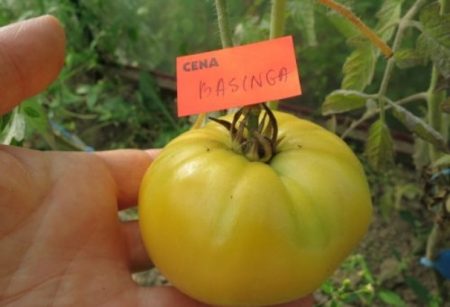 Many gardeners prescribe tomato seeds from collectors, finding in this way the most productive and delicious varieties. Such collection tomatoes include the Basinga variety, bred for a long time in the United States. It is even mentioned in the famous book by K. Mail about old American tomatoes, and today it is grown with pleasure in many different countries.
Many gardeners prescribe tomato seeds from collectors, finding in this way the most productive and delicious varieties. Such collection tomatoes include the Basinga variety, bred for a long time in the United States. It is even mentioned in the famous book by K. Mail about old American tomatoes, and today it is grown with pleasure in many different countries.
Content
Grade description
Basinga is an indeterminate type tomato, powerful and tall. Usually it is recommended for growing in greenhouses (film, polycarbonate), but it grows well in open ridges.
In shelters, the height of the plant can reach 2-2.2 meters, in open ground - up to 1.7-1.9 meters. The bush is medium-leafed, needs a mandatory garter to the support.
In addition to garter, formation, this variety needs compulsory stepsoning. It is impossible to delay with the removal of stepsons, this affects the yield of tomato.
By ripening dates it belongs to mid-season tomatoes (100-115 days), but the time of harvesting the first fruits largely depends on the care, as well as the conditions for growing the crop. Judging by the reviews, the Basinga variety is successfully grown in all regions of the Russian Federation, receiving an excellent crop.
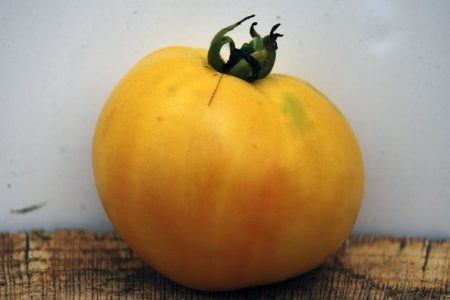
Tomatoes of this variety have an interesting barrel-shaped, large and dense. Even more original is the color - creamy yellow, with a pinkish speck on the top of the fetus. From this pink “hat” the vein rays diverge, and the tomato looks very elegant.
Basinga is a tomato that is part of the group of amazing bicolor tomatoes. They all differ in the colorful color of the skin, where two or more shades can be present.
By weight, tomatoes reach an average of 200-250 grams, but can be larger - up to 400 grams.
Inside the dense creamy skin - juicy, granular flesh. There are few chambers with seeds; everything is occupied by fleshy sweet pulp. The taste is excellent, barely noticeable fruity notes are felt.
This tomato is considered one of the best for salads, mashed potatoes and juices. Its unusual coloring, coupled with taste, makes Basinga a favorite of kids, and kids know a lot about delicious vegetables.
Basinga - tomato from the category of "favorites"
Basing's index is appreciated by gardeners for productivity and unpretentiousness. The "pluses" include:
- great taste of two-color fruits;
- resistance to adverse weather conditions;
- the ability to grow tomatoes both in the beds and in greenhouses.
Basingu is celebrated as one of the best salad varieties, the fruits of which are ideal for feeding children, as well as for dishes of the diet menu. It is willingly grown by gardeners from the USA, Canada, European countries, as well as our, domestic summer residents.
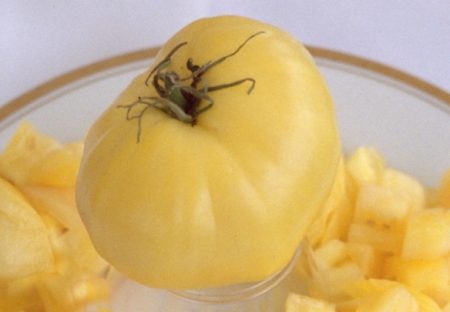
Judging by the reviews, one should single out the possibility of cracking the fruits from the “minuses”, although this is most likely the result of not quite the right care. Otherwise, there are no complaints about the tomato: tasty, fruitful, easy to care for. And even, despite the need for the formation of a bush, obligatory pinching, this variety is possible even for beginners, the main thing is to perform all the techniques of agricultural technology.
Growing and Care Recommendations
The Basinga variety in most regions of the Russian Federation is grown, like many other varieties and hybrids, by seedlings. This allows you to get the first fruits in July and harvest until the fall.
Take care of seedlings
Given that, on average, tomatoes can be planted in a greenhouse in May, sowing seeds for seedlings in March. Prior to this, they prepare the soil for tomatoes, containers where they will grow, disinfect and germinate the seeds.
Store nutrients are also suitable as nutritious soil mixtures, but not purely peaty ones. To this soil, it will be necessary to add soil, humus, baking powder (perlite, coarse river sand). A great option is to make the soil yourself, in advance, from the fall, by preparing the ground (turf or picking it under deciduous trees), humus, sand. Ash can be added to the soil (1-2 tablespoons per liter).

Basinga is a powerful tomato, therefore, from the very beginning, plants need nutritious balanced soil.
As utensils for seedlings, they select:
- boxes, containers (if they are first sown in common containers);
- cups made of peat, plastic (if they will not dive).
For the preparation of seeds using potassium permanganate (soaking for 20 minutes), growth stimulants EPIN, ZIRCON (soaking according to instructions), ash infusion. Germination is carried out in moist tissue.
Germinated seeds are sown in grooves, slightly sprinkled with earth, covered with glass from above and cleaned in a dark place. It is very important in this and subsequent periods to control the temperature:
- during germination it should be + 24ºC ... + 25ºC;
- after the appearance of sprouts: + 17ºC ... + 18ºC;
- seedling growing period: + 21ºC ... + 23ºC.
It is advisable to ventilate the room, but avoid drafts. Simple care: moderate watering seedlings (as soon as the soil dries up), fertilizing with complex fertilizer.
If a dive is carried out (with the appearance of 2-3 leaves) of seedlings, then tomatoes do not feed him.
Two weeks before transplanting tomatoes into the greenhouse, it is important to harden them. This is an important procedure that allows plants to tolerate stress faster and easier. To do this, seedlings directly in the cups are taken out into the air, starting from 15-20 minutes and then leaving them on the veranda or balcony with open windows for the whole day.
After such preparation, the plants are ready for transplantation.
Greenhouse care
Usually, in the middle lane, Basingo is planted in the greenhouse in early or mid-May. In the regions of the North-West, as well as the Ural and Siberian regions, it is not worth rushing even with planting in greenhouses, the risk is too high that the tomatoes will fall under return frosts.
Soil temperature should be around + 14ºC ... + 16ºC, then the plants will feel comfortable. Tomatoes in the greenhouse can be additionally covered with non-woven material for the first time.
Planting Basing tomato planting: three plants per square meter. Thicken is not worth it, it can cause a decrease in tomato productivity. After planting, the plants are not watered (about 5-6 days), this will push the root system to growth and better development. Further irrigation is carried out approximately twice in 7-8 days, using only warm and settled water. It is difficult to give an accurate watering schedule; much depends on weather conditions and the condition of plants.
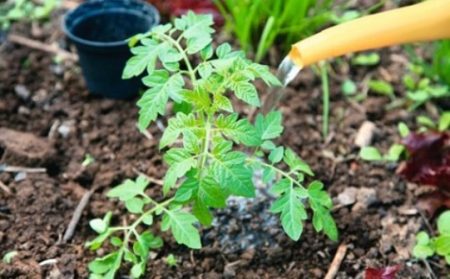
When growing tomatoes in a greenhouse, it is very important to control the air temperature. Gardeners with experience know that tomatoes, although heat-loving plants, can not tolerate intense heat and dry air. High humidity is also harmful to them, since a greenhouse effect is created and tomatoes begin to hurt.
The best temperature in the greenhouse for tomatoes: + 22ºC ... + 25ºC; at night from + 18ºC to + 20ºC.
A good result is the use of mulch - peat, humus, mowed grass. It does not allow weeds to grow, but most importantly, it provides the optimum level of soil moisture.
Fertilizers are required, since without proper nutrition Basinga reduces productivity. To form fruits on powerful shoots, nitrogen, phosphorus, potassium are needed, and most often gardeners use complex fertilizers.
Nitrogen fertilizers prevail in the first half of the growing season when diluted mullein (1:10) or bird droppings (1:20) are used. When the tomatoes begin to bloom, the process of fruit formation will begin. It is necessary to include potassium and phosphorus in the fertilizing.
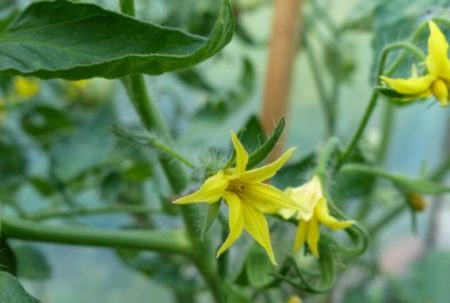
Do not exceed the dose of fertilizers, especially nitrogen, as this leads to an increase in the green mass of plants to the detriment of the fruits.
Gardeners who do not seek to use "chemistry" on the site, prefer such compounds:
- infusion of herbs;
- ash infusions.
Also, to increase productivity, spraying plants with boric acid, iodine, yeast infusion is used.
Despite the fact that the Basinga tomato variety is resistant to infections and diseases, it is important to follow all the rules of agricultural technology, to carry out prevention. Some recommendations:
- Water the tomatoes only with warm water.
- Watering is done under the root or in special holes, grooves so that moisture does not fall on the leaves of plants.
- Be sure to ventilate the greenhouse.
- Bushes the stepsons, removing all unnecessary shoots at an early stage.
- Mulch the soil.
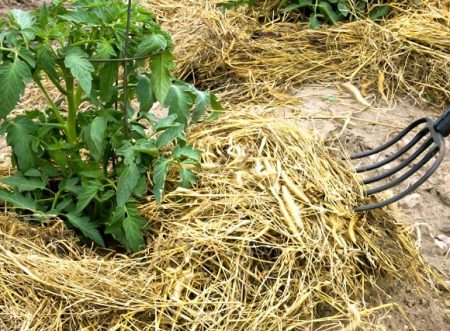
The bush, as already mentioned, is formed in 2-3 stems. Stakes are used as supports; the trellis method of growing is also very suitable.
Harvesting tomatoes is carried out in a state of technical ripeness, without waiting for their full ripening on the bush. This will enable the plant to form the following fruits, which helps to increase the overall yield.
Reviews about the variety of basing tomatoes
Natalya, Saratov Region
Tomato Basingu received seeds from a friend, and she also wrote out from a collector. This tomato was praised for its taste, so I decided to try it. What can I say - a delicious and beautiful tomato! The yield is just excellent, it grew in the garden (I did not have a place for it in the greenhouse, the seeds later came, and everything was already planned). Next year I’ll plant in a greenhouse. There were a lot of tomatoes; the color was neither white nor yellow. Appeared among ripening on the bush and pinkish color, so that bicolor - for sure. Taste - similar to apple mixed with pear and something else fruit.
Elena, Leningrad Region
This variety is grown for the third year. I like the taste of tomatoes, as well as productivity. True, in the description (I read one about it on the forum) it was written that the fruits are yellow. At me they grew more likely, some white and lemon. There was almost no red hue, just a large creamy tomato. Very tasty, fleshy and fragrant. Used mainly in salads, just ripened directly from the bush. Yummy!
Dmitry, Uglich
I have many different varieties of tomatoes growing, I like to pick unusual ones. Basing, like many other American tomatoes, wrote out, 6 seeds came. The tomato pleased, the yield is very decent, and I would also note the good taste of the fruits. But I want to say right away that this variety must be well fed, like many other tall tomatoes. Then it will justify your hopes, even if the summer will not be very. Although, as I noticed, in warm summer tomatoes are still tastier and juicier, the sun plays a big role.




 Low-growing tomatoes, without pinching: 5 of the most delicious varieties
Low-growing tomatoes, without pinching: 5 of the most delicious varieties Why tomato seedlings grow poorly
Why tomato seedlings grow poorly We grow a tomato in a shell
We grow a tomato in a shell Growing tomatoes without watering according to the method of Kazarin
Growing tomatoes without watering according to the method of Kazarin